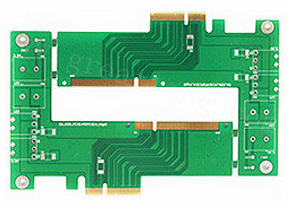Panelize the circuit board (PCB) into a [Yin-Yang board or Mirror Board], although it can increase the efficiency of the SMT production line and also has the advantage of saving material costs, but these two [Yin-Yang board] designs However, they have their own shortcomings and limitations. This article will discuss and seek their solutions.
Further reading: The advantages of PCB using "yin and yang board" jigsaw
Regarding the "Inverted Yin-Yang Board", the limitation is that it is not recommended to be used on a board with heavier parts, because heavier parts are usually placed on the second side before being printed, which can prevent heavier parts from being returned a second time. There is a risk that the solder paste will re-melt and fall during the reflow oven.
Although it is not recommended, there is still a way to solve it, but it takes a little more work and it is necessary to sum up whether the total is cost-effective.
Method 1: You can dispense the heavier parts. The early PCB lines, the red glue process and the dispenser are necessary equipment, because the parts that have been dispensed can be used for wave soldering., The current PCB line does not necessarily have this equipment. If not, you can also consider dispensing by hand, but I don't recommend it because the quality of manual work is difficult to control.

Method 2: Use a carrier. The carrier of the reflow oven can be designed to just support the heavier parts, so that the heavier parts are not easy to fall after the second reflow soldering. However, the cost of a carrier is not cheap, and the total number of carriers must be greater than the length of the reflow oven, that is, to calculate how many boards are in the reflow oven at the same time, and spare parts ( buffer), all add up to not 30 but also more than 20, which is not a waste of money. In addition, the carrier needs to withstand the high temperature of repeated reflow soldering, so it is generally made of metal material or special high-temperature resistant plastic. There is also a special reminder that using Carrier will require an additional labor cost, and putting the board on the Carrier also requires labor.
Method 3: Hand-welding heavier parts. Personally, this method is not recommended because it is difficult to control the quality manually, and some parts are not easy to weld by hand.
In addition, there is another problem with the "inverted yin and yang boards", that is, some boards may use parts that are easy to absorb heat on one side (such as large-area ATM card reader slots). These parts require a longer heating time to achieve The melting temperature of the solder paste, but not to burn other weaker parts. This kind of board needs to pay special attention to the adjustment of the reflow profile.
As for the "inverted yin and yang boards on the same side upside down", it is basically not very helpful to the efficiency of the PCB line, but it can achieve the purpose of saving board. How to cut the edge of the board is only a problem that needs to be considered for this kind of jigsaw. In normal splicing, V-Cut can usually be used to cut the edge of the board, which saves the cost, but it is limited to make the Yin-yang board because V-Cut can only be used for full straight cutting, and the curved board edge is only It depends on the Router machine.
After the board is assembled, it is easy to have a Cross Board (playing an X board), and the more boards are assembled, the more opportunities for the X-board. X-board is a product that will inevitably appear in the manufacturing process of PCB board factories. The so-called X-board means that there are more than one bad board in the jigsaw. Generally, the board factory will use a pen to mark an X on the bad board, so it is called X -board. Most SMT manufacturing factories do not want to accept this kind of board, because it will cause a loss of efficiency, but this kind of circuit board cannot be absolutely avoided in the manufacturing process, so the more the number of boards, the number of scrapped circuit board factories will be The more, the relative cost will increase. Therefore, circuit board manufacturers will hope that the number of connected boards is as small as possible, because this can avoid the loss of X-board. Of course, the wool is still on the sheep. If the board manufacturer has been unable to overcome the loss of X-board, the final price will still be Reflect on the customer.
In fact, some professional PCBA foundries (OEMs) will post-manufacture the panels manually, but they need to use some skills and have to admire the ideas of these PCB manufacturers.